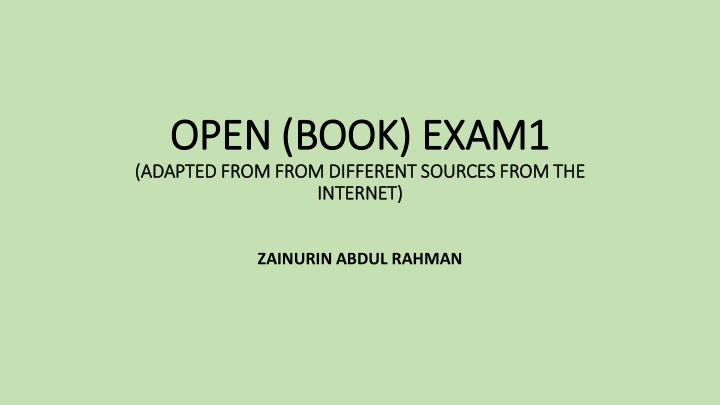



OPEN (BOOK) EXAM1 (A (ADAPTED FR FROM FR FROM DIFF IFFERENT SOURCES FR FROM THE IN INTERNET) ZAINURIN ABDUL RAHMAN
Acknowledgement • I would like to thank all the owners of the different materials from the Internet that I have used in this presentation. The materials are super fantastic and helps me highlight my points. • I have lost track of the sources and their origins and this is my way of recognizing and thanking them.
What we should accept …. • We are caught in this quagmire … it’s not our doing - telling students about open book exam now is different from telling students about open book exam at the beginning of the semester - fulfilling requirements (regulatory and accreditation bodies, other institution) - things are not the same for all (science-based vs arts-based) - short-term vs long-term methods of handling the issue
TOC OF OPEN-BOOK EXAMS GUIDE FOR CANDIDATES University of Oxford 2020
Closed Book vs Open Book http tps://p //petit ition.parlia iament.uk/archiv ived/p /petit itio ions/2 /200299 • Conservative government 2017-2019 debated Book or Open Book Exam?
Outline • Concept - what is it? - types - avoiding plagiarism • Procedure - what to do? - formulating test items • Process flow (beginning to end) • Platform/Medium - training - “UAT” or sort of…..
Concept: What is it? • allows students to take/use materials/aids in exams • r equires students’ to display/prove their abilities in discussing critically the applications and the interplays of different elements in a body of knowledge that have and/or have not been covered in a class • test items are more real and authentic , mimicking what’s is going on in the discipline of studies or in real life • process leading towards grading is stringent since the amount of time given to students is generally long to complete the exam • heavy on the instructor to set open book exam – must be very clear
Concept : Types of Open Book Exam • Traditional* (Type 1) - sitting-in exam - normally paper-and-pencil - venue- and time-determined - variable amount of notes and facilitative materials • Take home* (Type 2) - almost opposite of the above - the answer can be returned in a longer specified time - variable amount of notes and facilitative materials *printed, digital or student-prepared facilitative materials depend on the instruction
Concept: Avoiding plagiarism • different set of questions that are comparable to each other (TOS) • manage time well, like …. very well • Turnitin • items should be from HOTS and require critical thinking rather than mere “lifting” from the materials • s tudents’ integrity declaration and code of conduct
Procedure: Making decisions Have all these items handy: • Course outline (pay attention to statement of LOs, TnL methods, Assessment Methods and weightage) • Resources available (for lecturers and students) • Classroom make-up • Assessment instruments • TOS or plan for assessment
Procedure: Formulating integrative test items • if students must produced something, the product must be something that can’t be purchased or customized by other people • at the most two (2) test items • fulfilling the identified LOs in the course outline • do students have resources available to complete the tasks given • number of students in the class – the more the worse • MUST clearly indicate what is expected of the students to do. DO NOT create confusion among students about how exactly they should answer the questions • prepare assessment instruments – marking scheme, rubrics (holistic or analytic)
Process Flow (beginning to end) … proposed • Lecturers notify kulliyyah to conduct Open book exam • Lecturers submit Examination Materials for vetting • Lecturers submit the approved/endorsed Examination Materials to the relevant offices • Relevant offices administer the examination using the agreed platform (so what’s the issue) • Relevant offices compile all students’ answers/responses • Relevant offices pass all students’ answers/responses to respective lecturers • Lecturers mark paper within the stipulated time given • Lecturers submit marks to relevant offices • Other processes continue accordingly
Platform/Medium for Open Book Exam • to be determined by technical individuals or experts in IT, Education and Assessment • not the same as the platform/medium for online TnL • available and accessible to lecturers and students? • if the platform/medium is identified, does it require training or not? • once training has been given can we have a UAT (User Acceptance Test)? • never assume anything or everything
Recommend
More recommend